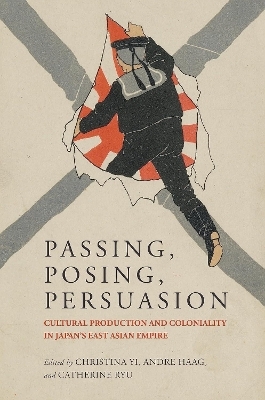
Passing, Posing, Persuasion
Cultural Production and Coloniality in Japan's East Asian Empire
Seiten
2023
University of Hawai'i Press (Verlag)
978-0-8248-9630-0 (ISBN)
University of Hawai'i Press (Verlag)
978-0-8248-9630-0 (ISBN)
Interrogates the intersections between cultural production, identity, and persuasive messaging that idealized inclusion and unity across Japan’s East Asian empire (1895-1945). Chapters emphasize the plurality and heterogeneity of empire, together with the contradictions and tensions of its ideologies of race, nation, and ethnicity.
Passing, Posing, Persuasion interrogates the intersections between cultural production, identity, and persuasive messaging that idealized inclusion and unity across Japan’s East Asian empire (1895–1945). Japanese propagandists drew on a pan-Asian rhetoric that sought to persuade colonial subjects to identify with the empire while simultaneously maintaining the distinctions that subjugated them and marking their attempts to self-identify as Japanese as inauthentic, illegitimate forms of "passing" or "posing." Visions of inclusion encouraged assimilation but also threatened to disrupt the very logic of imperialism itself: If there was no immutable difference between Taiwanese and Japanese subjects, for example, then what justified the subordination of the former to the latter? The chapters emphasize the plurality and heterogeneity of empire, together with the contradictions and tensions of its ideologies of race, nation, and ethnicity.
The paradoxes of passing, posing, and persuasion opened up unique opportunities for colonial contestation and negotiation in the arenas of cultural production, including theater, fiction, film, magazines, and other media of entertainment and propaganda consumed by audiences in mainland Japan and its colonies. From Meiji adaptations of Shakespeare and interwar mass media and colonial fiction to wartime propaganda films, competing narratives sought to shape how ambiguous identities were performed and read. All empires necessarily engender multiple kinds of border crossings and transgressions; in the case of Japan, the policing and blurring of boundaries often pivoted on the outer markers of ethno-national identification. This book showcases how actors—in multiple senses of the word—from all parts of the empire were able to move in and out of different performative identities, thus troubling its ontological boundaries.
Passing, Posing, Persuasion interrogates the intersections between cultural production, identity, and persuasive messaging that idealized inclusion and unity across Japan’s East Asian empire (1895–1945). Japanese propagandists drew on a pan-Asian rhetoric that sought to persuade colonial subjects to identify with the empire while simultaneously maintaining the distinctions that subjugated them and marking their attempts to self-identify as Japanese as inauthentic, illegitimate forms of "passing" or "posing." Visions of inclusion encouraged assimilation but also threatened to disrupt the very logic of imperialism itself: If there was no immutable difference between Taiwanese and Japanese subjects, for example, then what justified the subordination of the former to the latter? The chapters emphasize the plurality and heterogeneity of empire, together with the contradictions and tensions of its ideologies of race, nation, and ethnicity.
The paradoxes of passing, posing, and persuasion opened up unique opportunities for colonial contestation and negotiation in the arenas of cultural production, including theater, fiction, film, magazines, and other media of entertainment and propaganda consumed by audiences in mainland Japan and its colonies. From Meiji adaptations of Shakespeare and interwar mass media and colonial fiction to wartime propaganda films, competing narratives sought to shape how ambiguous identities were performed and read. All empires necessarily engender multiple kinds of border crossings and transgressions; in the case of Japan, the policing and blurring of boundaries often pivoted on the outer markers of ethno-national identification. This book showcases how actors—in multiple senses of the word—from all parts of the empire were able to move in and out of different performative identities, thus troubling its ontological boundaries.
Christina Yi is associate professor of modern Japanese literature at the University of British Columbia. Andre Haag is assistant professor of Japanese literature and culture at the University of Hawai‘i at Mānoa. Catherine Ryu is associate professor of Japanese literature and culture and director of the Japanese Studies Program at Michigan State University.
| Erscheinungsdatum | 05.12.2023 |
|---|---|
| Zusatzinfo | 5 b&w illustrations |
| Verlagsort | Honolulu, HI |
| Sprache | englisch |
| Maße | 152 x 229 mm |
| Gewicht | 272 g |
| Themenwelt | Kunst / Musik / Theater ► Film / TV |
| Geschichte ► Allgemeine Geschichte ► Neuzeit (bis 1918) | |
| Geisteswissenschaften ► Geschichte ► Regional- / Ländergeschichte | |
| Sozialwissenschaften ► Kommunikation / Medien ► Medienwissenschaft | |
| Sozialwissenschaften ► Politik / Verwaltung ► Vergleichende Politikwissenschaften | |
| ISBN-10 | 0-8248-9630-0 / 0824896300 |
| ISBN-13 | 978-0-8248-9630-0 / 9780824896300 |
| Zustand | Neuware |
| Haben Sie eine Frage zum Produkt? |
Mehr entdecken
aus dem Bereich
aus dem Bereich
Europa 1848/49 und der Kampf für eine neue Welt
Buch | Hardcover (2023)
DVA (Verlag)
48,00 €
Giordano Bruno - ein ketzerisches Leben
Buch | Hardcover (2024)
C.H.Beck (Verlag)
29,90 €


